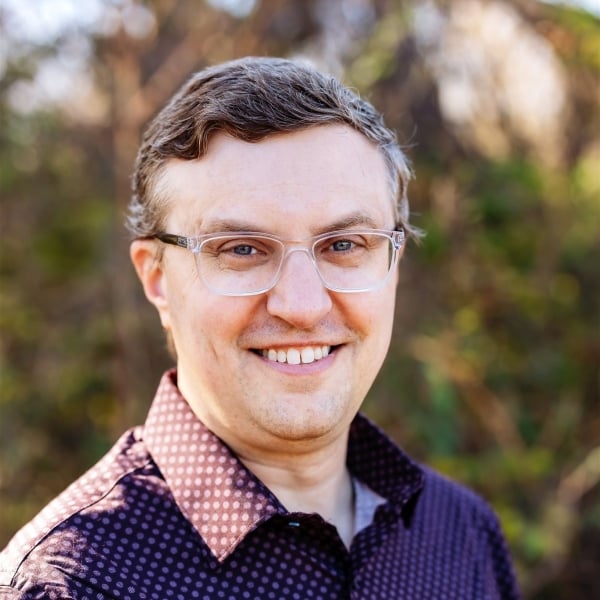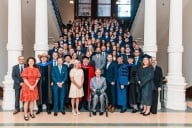You have /5 articles left.
Sign up for a free account or log in.
This past August, UVA’s Center for Teaching Excellence announced that Derek Bruff would join the center as an associate director for the 2024–25 academic year.
Those who have worked in and around the educational developer and digital learning worlds are likely familiar with Derek’s blog, books, newsletter and podcasts. Many of us have spent time with Derek when he is at conferences or events speaking or on our campuses while consulting. Or we know him from his work at the Center for Teaching at Vanderbilt University, where he served as executive director until 2022.
Derek’s UVA position is his second remote, temporary position, following a 21-month stint as visiting associate director at the Center for Excellence in Teaching and Learning (CETL) at the University of Mississippi. Since Derek is carving out something of a nontraditional academic professional path among nonfaculty educators, I thought it would be useful to our community to ask about his career choices and lessons.

Q: How can an experienced educational developer be useful to a center for teaching and learning in a one- or two-year position?
A: When Joshua Eyler brought me on board at CETL, my biggest project was to work with STEM instructors on campus to help them get ready for the opening of a new classroom building almost two years in the future. The new building would be full of active learning classrooms, and my goal was to help faculty get ready to make the most of these innovative spaces. UM had a few active learning classrooms at the time, but most STEM instructors taught in more traditional lecture halls. I spent much of my time at UM using my background in evidence-based STEM teaching to build relationships with STEM instructors there and create the kind of professional development resources (workshops, learning communities and so on) they needed to prepare for all their new classrooms.
CETL was also having something of a rebirth. It had been a “center for one” before Josh’s arrival, and it was known on campus as a place where faculty could get a free lunch and hear a great talk about an outside speaker. Josh’s approach to centers for teaching and learning is different, and part of why he brought me in was to help the teaching community there see the value of internal experts—that is, professional teaching center staff who can work with instructors over time. I wasn’t the only one Josh brought in—he also hired Emily Donahoe and Liz Norell, who are doing great work at UM and more broadly—but I think it helped to have a veteran like me join the center, even in a visiting position. My STEM background was particularly useful for building bridges with faculty and departments on campus.
I am now in a one-year position at the Center for Teaching Excellence (CTE) at the University of Virginia, working with director Michael Palmer and his amazing team. The CTE is a much more established center and a larger one, so I’m playing different roles there. Michael talks about having more projects to do than people to do them, so he’s having me use my particular set of expertise on some of those projects. I’m an editor for Teaching Hub, a website featuring curated collections of resources on a variety of teaching and learning topics. The old Vanderbilt University Center for Teaching website that I oversaw played a similar role in higher ed, so this is familiar territory for me. And I have a broad network of educational developer colleagues I can recruit to contribute to Teaching Hub.
The CTE is also supporting a provost initiative around generative AI in which about 50 faculty have been recruited to serve as AI guides, helping their colleagues make informed and intentional choices about the role of AI in their courses. Given my background in educational technology as well as all the work I’ve been doing at the intersection of AI and teaching over the last two years, I was able to jump right in and help develop programming to support the AI guides. I’ll also be helping CTE figure out how the faculty development resources available from OneHE might enhance our work at the university and I’ll be consulting with a number of STEM faculty leading change initiatives there, too. All of this work can be done largely remotely, which allows me to continue living in Nashville, Tenn., while visiting the UVA campus a few times during the academic year.
Q: What does it take for a mostly remote teaching center staff member to be effective?
A: Working remotely at a teaching center is not without its challenges, mainly because educational development is so relational. I’m always trying to get to know the teaching community at the universities I support, working to identify common teaching and learning challenges as well as the instructors who are finding creative and effective solutions to those challenges. Listening tours are key, and luckily those are pretty easy to do remotely thanks to videoconferencing. That said, in both of my remote positions, I’ve been able to spend some time on campus, and it’s important to make good use of that time to meet faculty and administrators and begin that relationship building. It helps to have a director who already knows the players on a campus and can help me decide who I need to meet in person and who I can meet virtually.
I’ve found that a lot of the programming that teaching centers do can be done remotely, like the one-on-one teaching consultations that are the bread and butter of many centers. Learning communities, where faculty and other instructors meet regularly to discuss a common teaching interest, work particularly well on Zoom since fitting meetings in busy faculty schedules is easier. Facilitating a meeting like that or a more structured teaching workshop on Zoom takes a certain skill set, but I and so many of my teaching center colleagues developed those skills in abundance back in 2020! I’m quite comfortable in that modality, and many of my faculty colleagues are, too.
Perhaps the most important ingredient is having a center staff and leadership who are amenable to remote work and the adaptations it can require. I’m actually the second remote staff member at the CTE, and most of my colleagues spend their time split between on campus and working from home. With hybrid staff meetings and a healthy use of email and Slack, it’s been easy for me to slide right into the work rhythms with my UVA colleagues. CETL was a little more of an adjustment, I think, but shifting to Zoom staff meetings so that I could participate has paid off for CETL staff in other ways. Both centers have realized that staff don’t have to be in the office five days a week to do really great work, and they’ve developed policies and procedures that support more flexible work arrangements.
Q: You've done some smaller contract jobs for other universities in addition to your full-time visiting positions. Why might a teaching center want to bring in an external person for specific projects?
A: My smaller gig work has centered on timely projects where my skills and background were particularly important. For instance, I did some instructional design work for the Da Vinci Center for Innovation at Virginia Commonwealth University. They were launching some design thinking microcredentials, and I had worked a lot with a design thinking initiative back at Vanderbilt. I could leverage my course design and content knowledge to help that project move forward. I hadn’t actually worked in Canvas before, but having overseen Brightspace support at Vanderbilt, it was an easy platform to pick up.
This fall I’ll be facilitating a virtual learning community on teaching with AI for Washington University in St. Louis. Like other teaching centers, they’ve been standing up a lot of programming on generative AI, but they felt they didn’t have the right internal expertise for this particular learning community, so they’re bringing me in to lead it. I did something similar two summers ago for New Mexico State University, and I really appreciated the insight the work gave me into how faculty at different universities are responding to the challenge of AI. It helps me be more cosmopolitan in my educational development work, a term I’ve heard Mary Wright use before.
I have also done a little work consulting with teaching centers about how they do what they do. Some teaching centers have brought me in as a formal external evaluator, usually working with a team of evaluators, while others have engaged me in less formal ways. Having directed a thriving teaching center for over a decade, I have a lot of experience in how teaching centers work and how they can make a difference at their institutions. I really enjoy bringing that lens to new institutions and making strategic recommendations.








